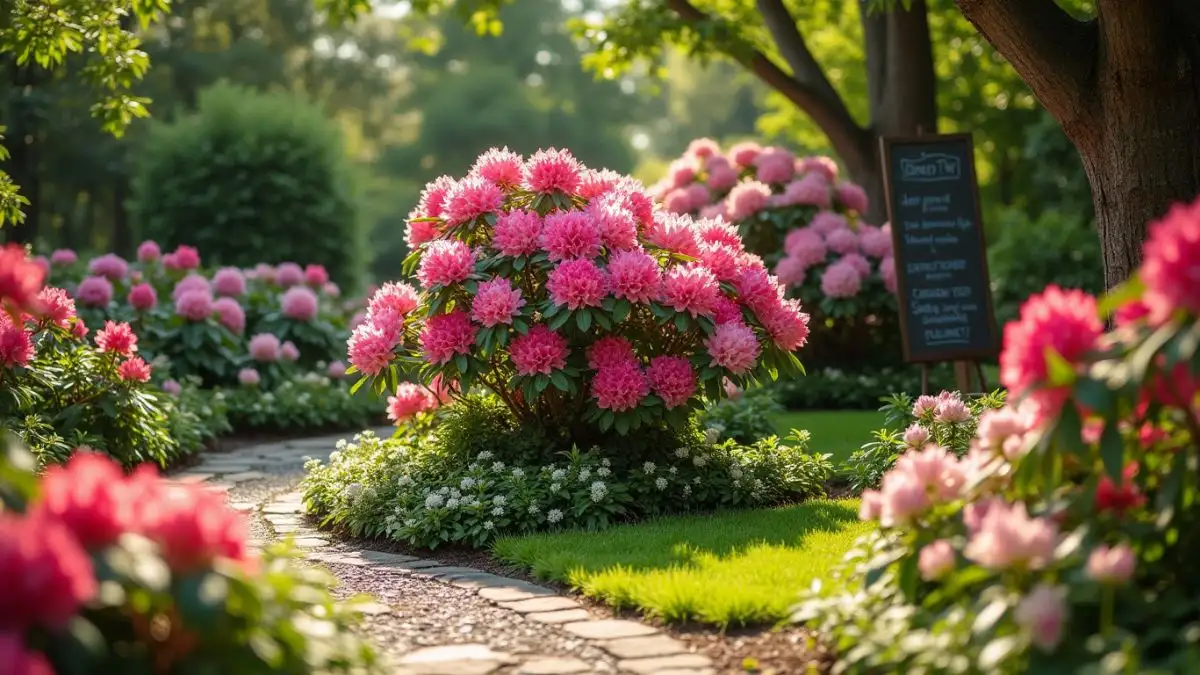Imagine stepping into a garden where vibrant rhododendron blooms create a sea of color, transforming your outdoor space into a breathtaking retreat. Sounds dreamy, right? With the right landscape ideas for rhododendrons, you can make this vision a reality.
Rhododendrons are more than just pretty flowers—they’re versatile, evergreen shrubs that bring year-round beauty to your garden. Whether you’re a seasoned gardener or just starting out, incorporating these stunning plants into your landscape can elevate your outdoor space to new heights.
In this guide, you’ll discover seven stunning landscape ideas for rhododendrons to help you create a garden that’s both beautiful and functional. From focal points to woodland retreats, we’ll cover everything you need to know to make your garden bloom with color and life.
Table of Contents
Why Rhododendrons Are Perfect for Landscaping
Rhododendrons are a gardener’s dream. Their vibrant blooms, lush foliage, and adaptability make them a standout choice for any landscape. Here’s why they’re so special:
- Year-Round Beauty: Unlike many plants that only shine in one season, rhododendrons offer evergreen foliage and stunning spring blooms.
- Versatility: They come in a range of sizes, from compact dwarf varieties to towering shrubs, making them suitable for any garden style.
- Shade Tolerance: Rhododendrons thrive in partial shade, making them ideal for woodland gardens or shaded areas where other plants struggle.
- Low Maintenance: Once established, they need little attention, making them ideal for busy gardeners.
If you aim to introduce color, texture, and structure to your garden, rhododendrons are the perfect choice.
7 Stunning Landscape Ideas for Rhododendrons
Ready to transform your garden? Here are seven creative landscape ideas for rhododendrons to inspire your next project:
1. Create a Rhododendron Focal Point

A single, well-placed rhododendron can become the star of your garden. Choose a variety with bold, eye-catching blooms like ‘Nova Zembla’ (red) or ‘Purple Splendor’ (deep purple).
- How to Do It: Plant the rhododendron in a prominent spot, such as the center of a garden bed or near an entrance. Surround it with complementary plants like ferns or hostas to enhance its beauty.
- Why It Works: A focal point draws the eye and creates a sense of balance in your garden design.
- Example: In a small backyard, plant a ‘Nova Zembla’ rhododendron near a seating area to create a stunning visual anchor.
2. Design a Rhododendron Border
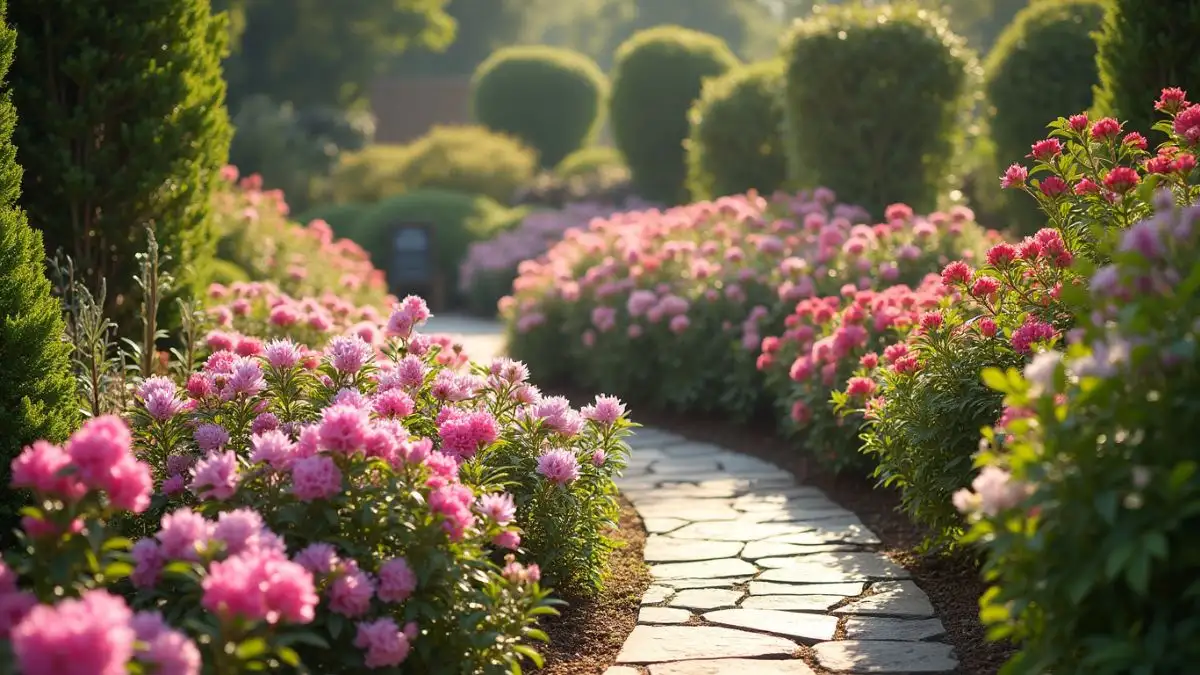
Use rhododendrons to create a natural border along pathways, driveways, or property lines. This not only adds color but also defines the space.
- How to Do It: Choose a mix of rhododendron varieties for a gradient of colors and heights. For example, pair ‘PJM Elite’ (lavender) with ‘Roseum Elegans’ (pink).
- Why It Works: Borders create structure and guide visitors through your garden.
- Example: Along a winding garden path, alternate ‘PJM Elite’ and ‘Roseum Elegans’ for a vibrant, cohesive look.
3. Build a Woodland Garden
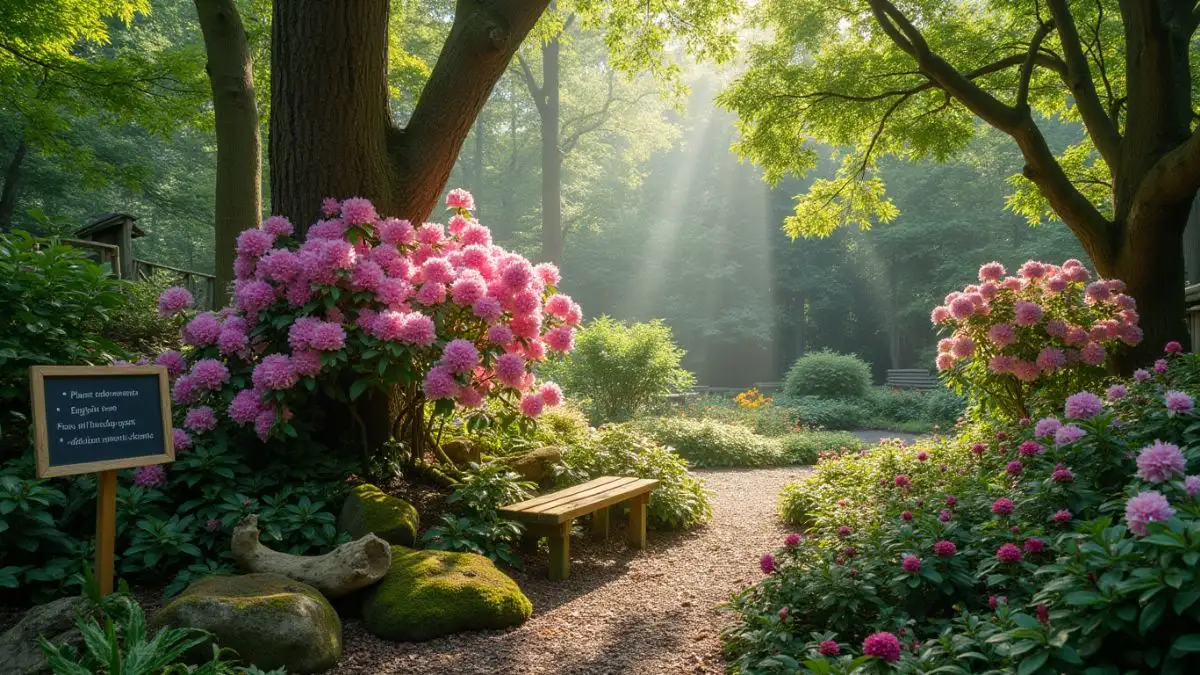
Rhododendrons are a natural fit for woodland gardens, where their shade tolerance and lush foliage shine.
- How to Do It: Plant rhododendrons under trees or in shaded areas. Pair them with other shade-loving plants like azaleas, hydrangeas, and bleeding hearts. Add natural elements like rocks and logs for a rustic feel.
- Why It Works: Woodland gardens evoke a sense of tranquility and blend seamlessly with natural surroundings.
- Example: In a shaded corner of your yard, create a woodland retreat with ‘Catawbiense Boursault’ (purple) and ‘English Roseum’ (pink) rhododendrons.
4. Incorporate Rhododendrons into Rock Gardens
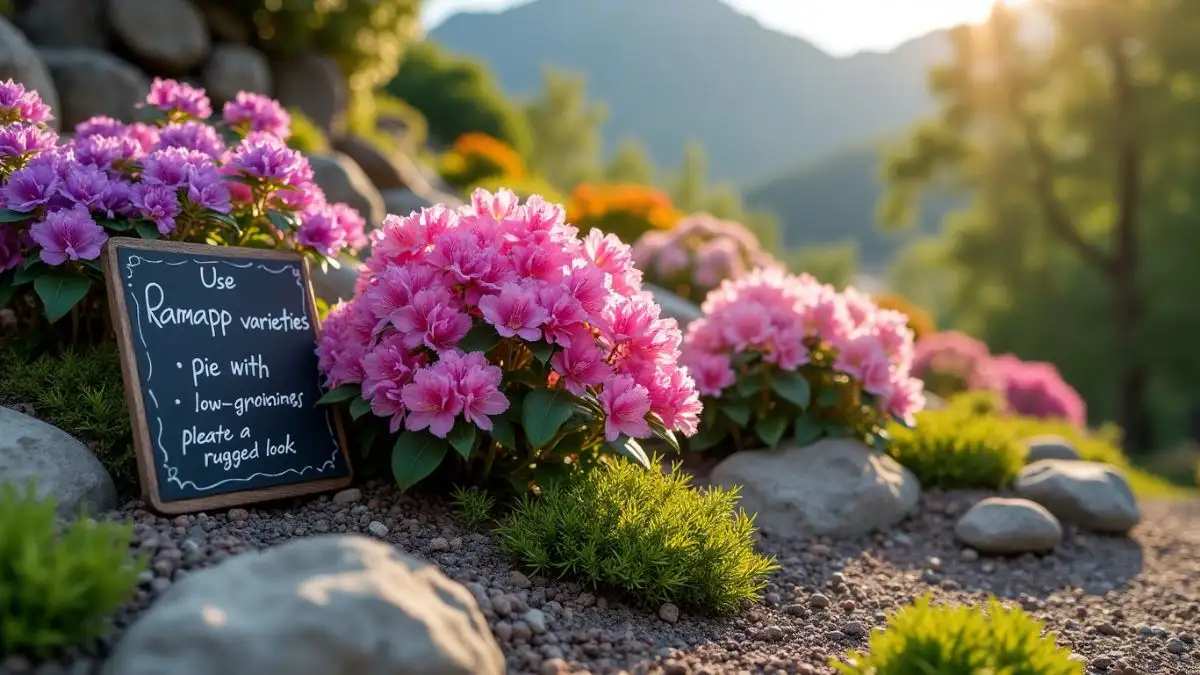
Dwarf rhododendron varieties are perfect for rock gardens, where their compact size and vibrant blooms add a pop of color.
- How to Do It: Plant rhododendrons among rocks and gravel, and pair them with low-growing plants like creeping thyme or sedum.
- Why It Works: Rock gardens create a rugged, natural look that’s both striking and low-maintenance.
- Example: Use ‘Ramapo’ (purple) or ‘Yaku Princess’ (pink) rhododendrons to add color and texture to a rock garden.
5. Design a Rhododendron Hedge
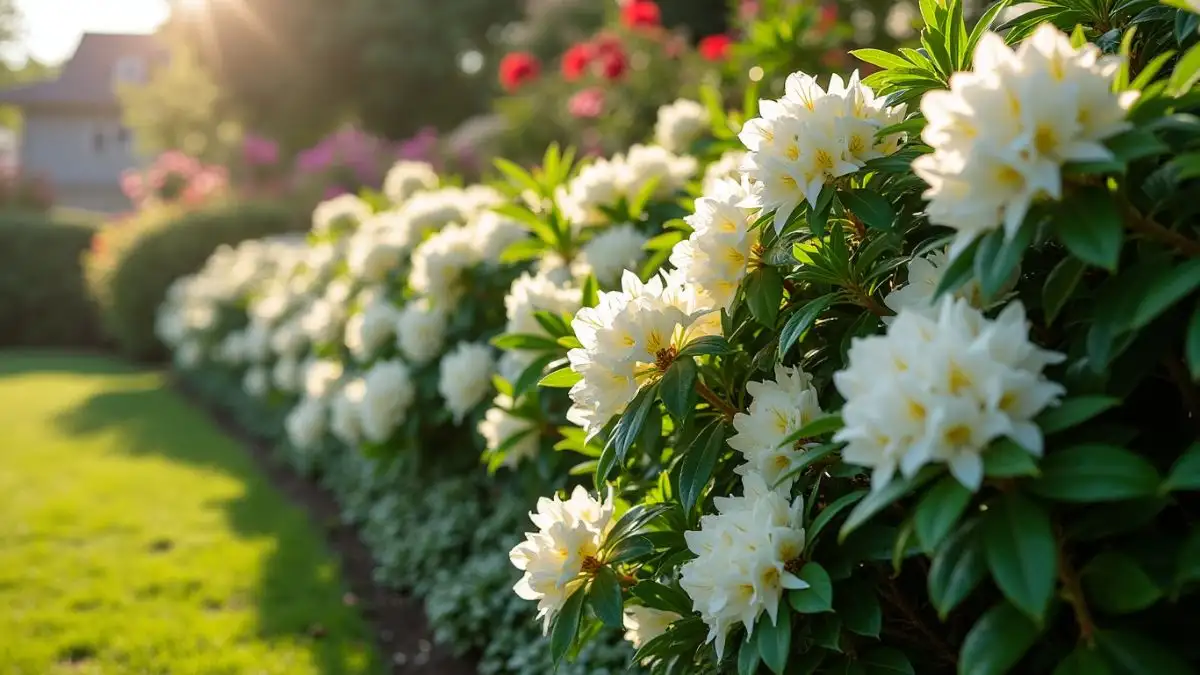
For privacy and beauty, plant rhododendrons in a row to create a living hedge.
- How to Do It: Choose dense varieties like ‘Cunningham’s White’ or ‘Scintillation’. Space them evenly and prune regularly to maintain shape.
- Why It Works: Hedges provide structure, privacy, and a backdrop for other plants.
- Example: Along a property line, plant ‘Cunningham’s White’ rhododendrons to create a lush, evergreen hedge.
6. Add Rhododendrons to Mixed Shrub Borders
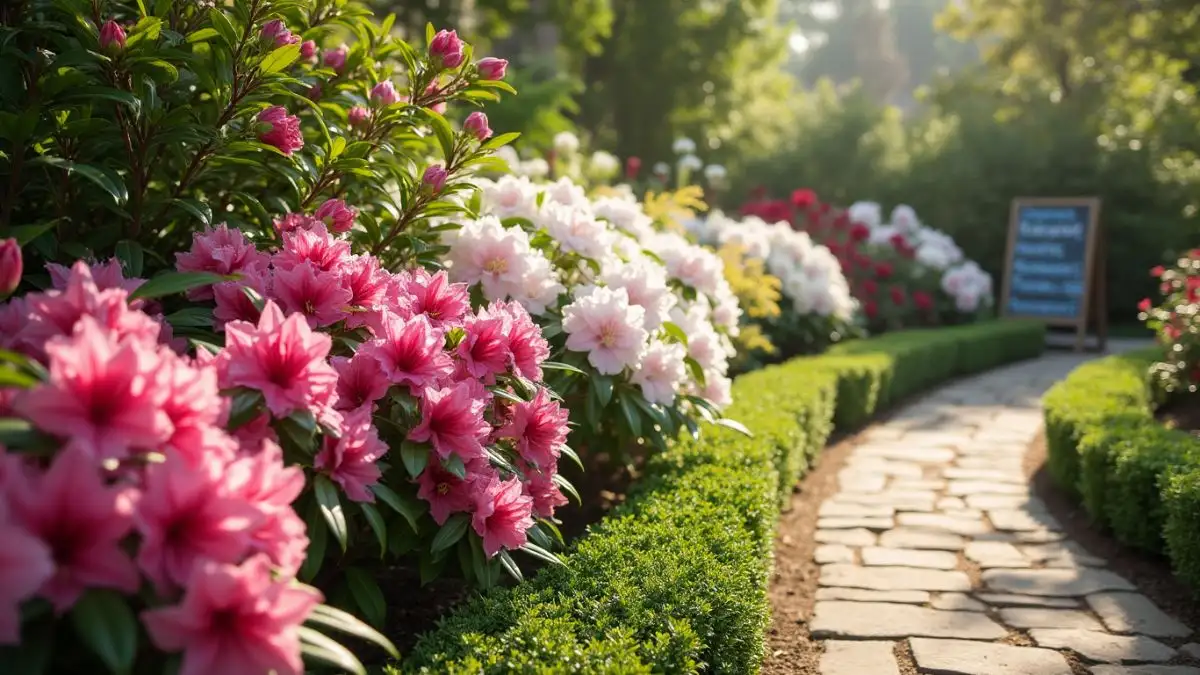
Combine rhododendrons with other shrubs for a dynamic, multi-layered look.
- How to Do It: Pair rhododendrons with camellias, viburnums, and boxwoods. Use contrasting textures and colors for visual interest.
- Why It Works: Mixed borders create depth and variety, making your garden more visually appealing.
- Example: In a large garden bed, combine ‘Scintillation’ (pink) rhododendrons with white camellias for a striking contrast.
7. Create a Rhododendron Pathway
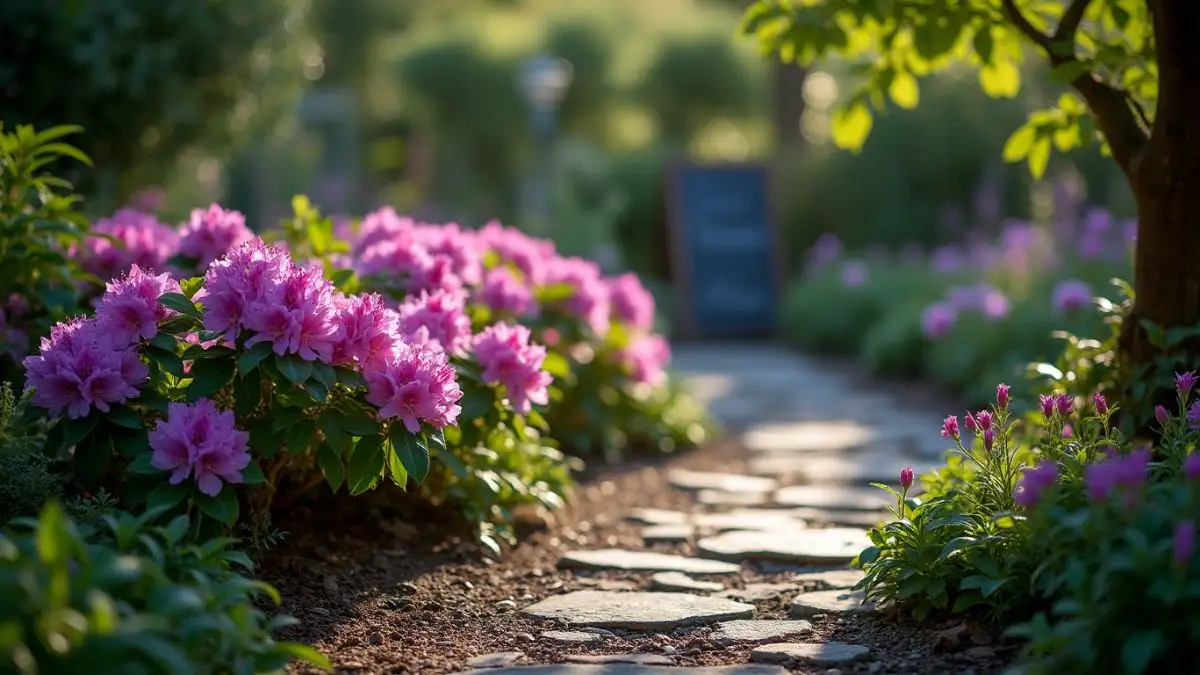
Line a garden pathway with rhododendrons for a dramatic, welcoming effect.
- How to Do It: Use low-growing varieties like ‘Purple Gem’ or ‘Ramapo’. Add lighting to highlight the blooms at night.
- Why It Works: Pathways lead visitors through your garden and foster a sense of exploration.
- Example: Along a meandering garden path, plant ‘Purple Gem’ rhododendrons to add a burst of color and texture.
Tips for Maintaining Rhododendrons in Your Landscape
To keep your rhododendrons healthy and thriving, follow these care tips:
- Soil: Grow in well-drained, acidic soil (pH 4.5–6.0).
- Watering: Water thoroughly once a week, and more frequently during dry periods.
- Mulching: Spread a layer of mulch to conserve moisture and stabilize soil temperature.
- Pruning: Trim after flowering to eliminate dead blooms and promote new growth.
Common Mistakes to Avoid
Even the most experienced gardeners can make mistakes. Here’s what to watch out for:
- Planting in Full Sun: Rhododendrons prefer partial shade. Excessive sun can burn their leaves.
- Overwatering: Poor drainage can lead to root rot. Ensure your soil is well-drained.
- Ignoring Soil pH: Rhododendrons need acidic soil. Check your soil and adjust it if needed.
How to Choose the Right Rhododendron Varieties
With so many varieties to choose from, it’s important to pick the right one for your garden. Consider these factors:
- Size: Choose dwarf varieties for small gardens or large shrubs for focal points.
- Bloom Color: Select colors that complement your existing landscape.
- Hardiness: Ensure the variety is suited to your climate.
Companion Plants for Rhododendrons
Pair rhododendrons with plants that thrive in similar conditions. Some great options include:
- Azaleas: Close relatives of rhododendrons, they offer similar care requirements and stunning blooms.
- Ferns: Their delicate fronds provide a beautiful contrast to rhododendron foliage.
- Hostas: Their broad leaves add texture and interest to shaded areas.
Seasonal Care for Rhododendrons
Rhododendrons require different care throughout the year. Here’s a seasonal guide:
- Spring: Fertilize with an acid-loving plant formula and prune after blooming.
- Summer: Water deeply during dry spells and mulch to retain moisture.
- Fall: Prepare for winter by adding a thick layer of mulch.
- Winter: Protect from harsh winds and heavy snow with burlap wraps.
Conclusion
Rhododendrons are a flexible and breathtaking enhancement to any garden. With the right landscape ideas for rhododendrons, you can create a space that’s both beautiful and functional. Whether you’re designing a woodland retreat, a rock garden, or a vibrant border, these tips will help you make the most of these incredible plants.
Ready to transform your garden? Pick up a rhododendron today and start planting! Share your preferred landscape ideas for rhododendrons in the comments below—we’d be delighted to hear from you.
FAQ Section
- What are the best rhododendron varieties for landscaping?
- Popular choices include ‘Nova Zembla’, ‘PJM Elite’, and ‘Catawbiense Boursault’.
- Can rhododendrons grow in full sun?
- They prefer partial shade but can tolerate morning sun with adequate moisture.
- How do I maintain soil acidity for rhododendrons?
- Use acidic mulch like pine needles and fertilize with an acid-loving plant formula.
- What plants pair well with rhododendrons?
- Azaleas, ferns, hostas, and hydrangeas are great companions.
- How often should I water rhododendrons?
- Water thoroughly once a week, and more frequently during dry periods.
- Can I grow rhododendrons in containers?
- Yes, use dwarf varieties and ensure the container has good drainage.
- When is the best time to plant rhododendrons?
- Early spring or fall, when the climate is cool and damp.
- How do I prune rhododendrons?
- Trim after flowering to eliminate dead blooms and shape the plant.
- What’s the ideal soil pH for rhododendrons?
- They flourish in soil with a pH of 4.5 to 6.0.
- Can rhododendrons be used as a hedge?
- Yes, choose dense varieties like ‘Cunningham’s White’ for a beautiful hedge.
This comprehensive guide provides everything you need to know about landscape ideas for rhododendrons and how to use them effectively. By following these tips and recommendations, you’ll be well on your way to creating a stunning, healthy garden. Happy planting!


